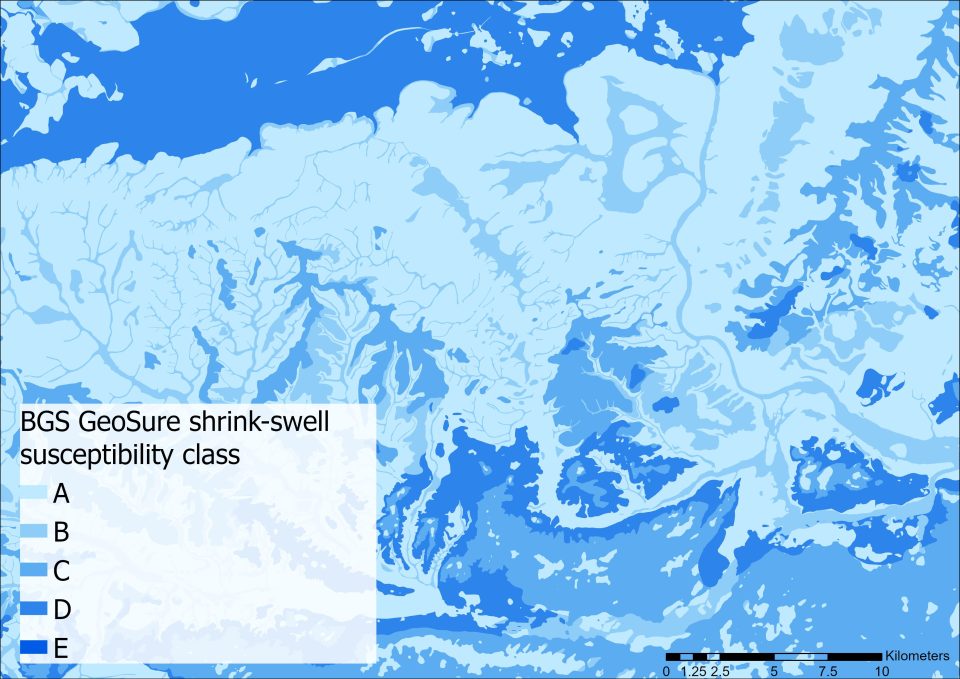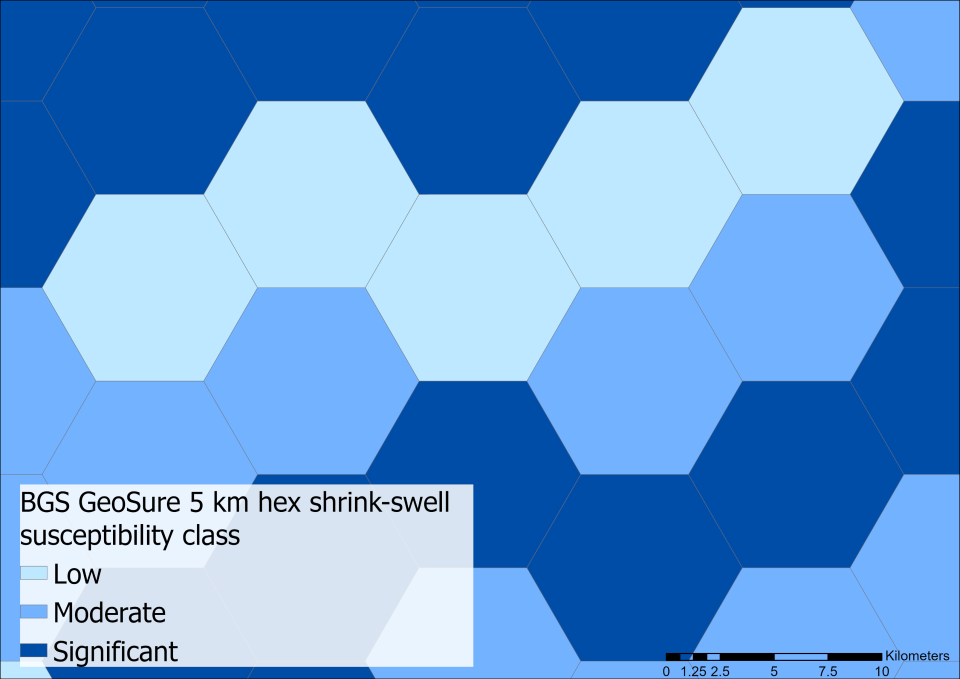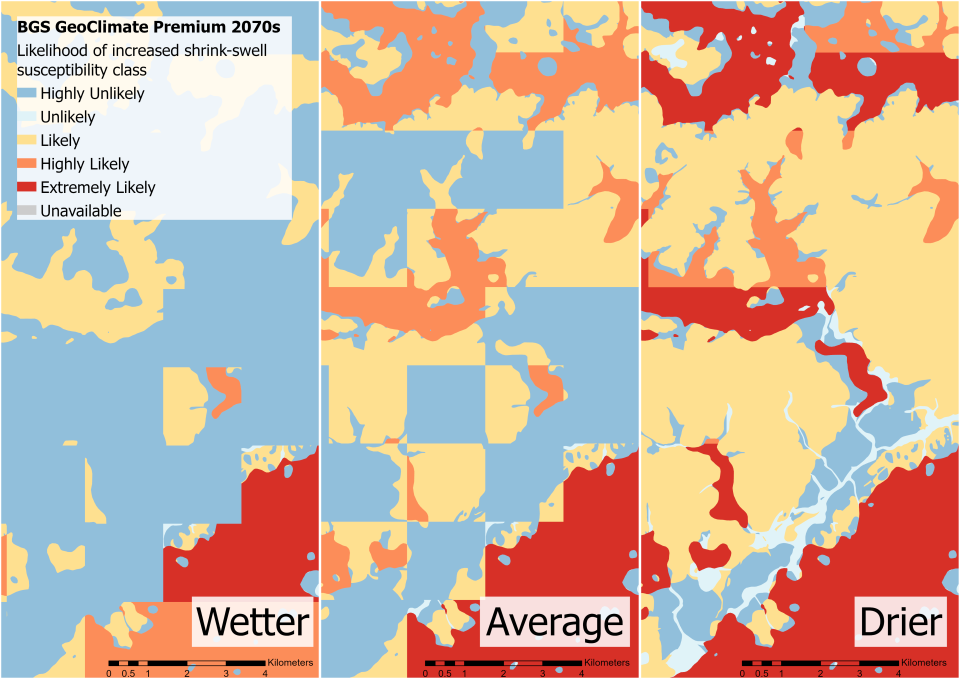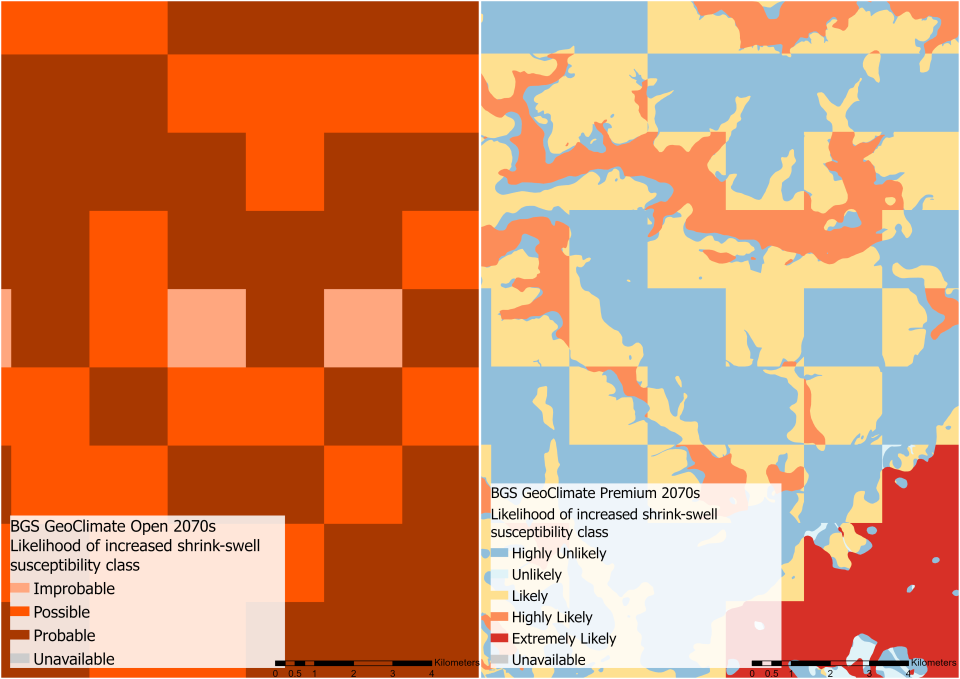Six BGS datasets for assessing shrink–swell subsidence hazards
Shrink–swell subsidence is one of the most significant geological hazards affecting the UK. BGS has six datasets to help assess the problem.
17/02/2023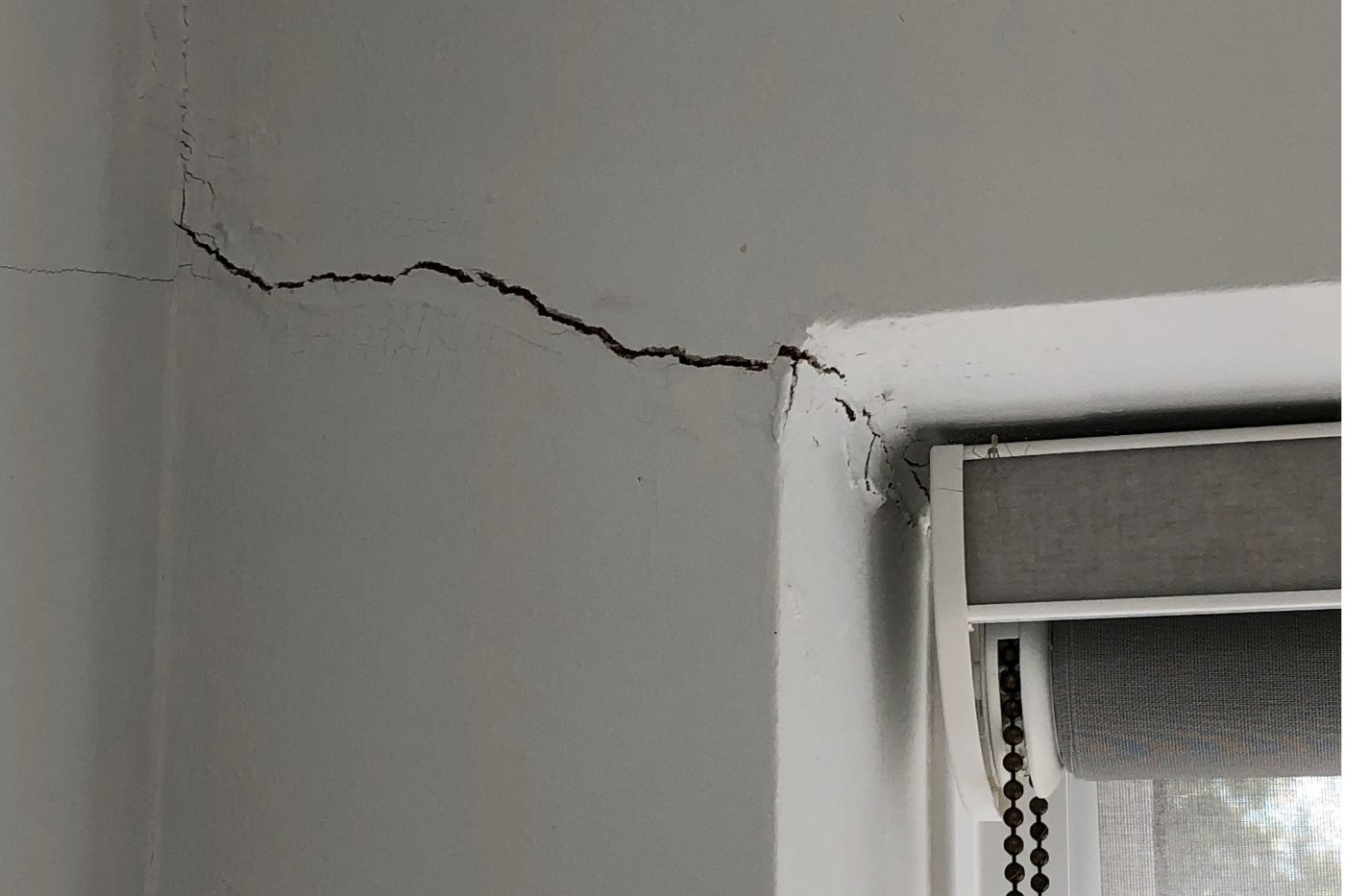
Many towns, cities and major infrastructure corridors in the UK are founded on clay-rich soils, especially in the south-east of the UK including much of London. Differences in the properties of underlying geology and regional climate across the UK result in localised changes in susceptibility due to shrink–swell subsidence (Jones and Jefferson, 2012; Jones et al., 2020). It is predicted that climate change will also have a significant effect on the magnitude and frequency of shrink–swell subsidence incidents.
Outlined here is the full range of BGS shrink–swell subsidence data products, which are designed to offer complementary assessments of susceptibility at a range of scales for a range of different uses and users. These include:
General users: Specialist users:- BGS GeoSure Insurance Product
- BGS Property Subsidence Assessment
- BGS GeoSure Extra Shrink–swell 3D
- BGS GeoSure Extra Shrink–swell Subsurface
The importance of BGS datasets
It is important to understand where shrink–swell hazard might be present to assess, adapt and mitigate for it. Natural ground instability may lead to financial loss if it is not correctly identified and infrastructure constructed accordingly.
This suite of data products from the UK’s premier geoscience institute can support the identification of this geohazard and the implementation of preventative measures, the cost of which may be very low compared to the cost of the repair following ground movement.
BGS GeoSure
What is it?
BGS GeoSure comprises natural ground stability data and consists of six data layers, including shrink–swell. Each layer is a national hazard susceptibility map for the following ground instability hazards:
- collapsible deposits
- compressible ground
- landslides
- running sand
- shrink–swell subsidence
- soluble rocks
What information does it provide?
This dataset shows areas of susceptibility for each hazard on a scale of A to E (low to high susceptibility) along with a class description. A free, open-source version of the BGS GeoSure datasets is available as a 5 km hex grid, which provides a generalised, national to regional overview of hazard susceptibility.
Coverage
- Great Britain
Suitable uses
This dataset can be used to assess the potential presence of geohazards that might affect low-rise buildings, and for the identification and classification of those geohazards.
Users could include:
- architects and surveyors
- developers
- home owners
- insurers and loss adjusters
- local government and regional planners
- solicitors
BGS GeoClimate Shrink–swell
What is it?
BGS GeoClimate Shrink–swell comprises national datasets showing potential change in subsidence due to changes in climate for the next century.
How is it different to GeoSure?
GeoClimate provides added detail for the potential effects of climate change. This is demonstrated through a number of different climate scenario thresholds.
What information does it provide?
UKCP18 climate projections and groundwater models are combined with GeoSure Shrink–swell hazard maps to model future shrink–swell susceptibility for two time periods: 2030s (2025 to 2035) and 2070s (206 to 2075). GeoClimate provides a ‘hot spot’ map of susceptible areas, which can inform mitigation strategies, prioritise works and aid risk reduction.
An assessment of the likelihood to experience an increase in susceptibility is provided for three scenarios for each time period. These represent wetter, drier and average future climate conditions, and convey the variation and uncertainty within the scenario modelling. This allows the user to consider the best- and worst-case scenario according to their needs.
A difference map is also provided to allow for comparison, detailing the relative change in GeoClimate classification compared to a modelled baseline period.
An open version of GeoClimate is freely available and consists of the average scenario for future climate conditions for the two time periods, provided on a 2 km grid.
Coverage
- Great Britain
Suitable uses
GeoClimate is of use to a broad range of market sectors dealing with resilience to future climate change including:
- heritage
- infrastructure operators
- local authorities
- planning and development
- utilities
BGS GeoSure Insurance Product

BGS GeoSure Insurance Product example. BGS © UKRI.
What is it?
The BGS GeoSure Insurance Product (GIP), designed specifically for use in the insurance sector, is an index-level assessment of the potential for a geological deposit to create financial insurance loss due to natural ground movement.
What information does it provide?
GIP incorporates the combined effects of the six BGS GeoSure hazards on (low-rise) buildings and links these to a postcode database. This database contains a normalised hazard rating for each of the six hazards (that is, each hazard has been balanced against each other). Full vector data is available for property assessment, whilst a combined unified hazard rating is available for each postcode in Great Britain.
Coverage
- Great Britain
Suitable uses
This dataset was developed for the insurance sector to quantify ground instability susceptibility in a way that is comparable between hazards and considers the potential effect on a building. It is also applicable to other financial sectors, such as banking or mortgage providers, for quantifying susceptibility of asset portfolios.
BGS Property Subsidence Assessment
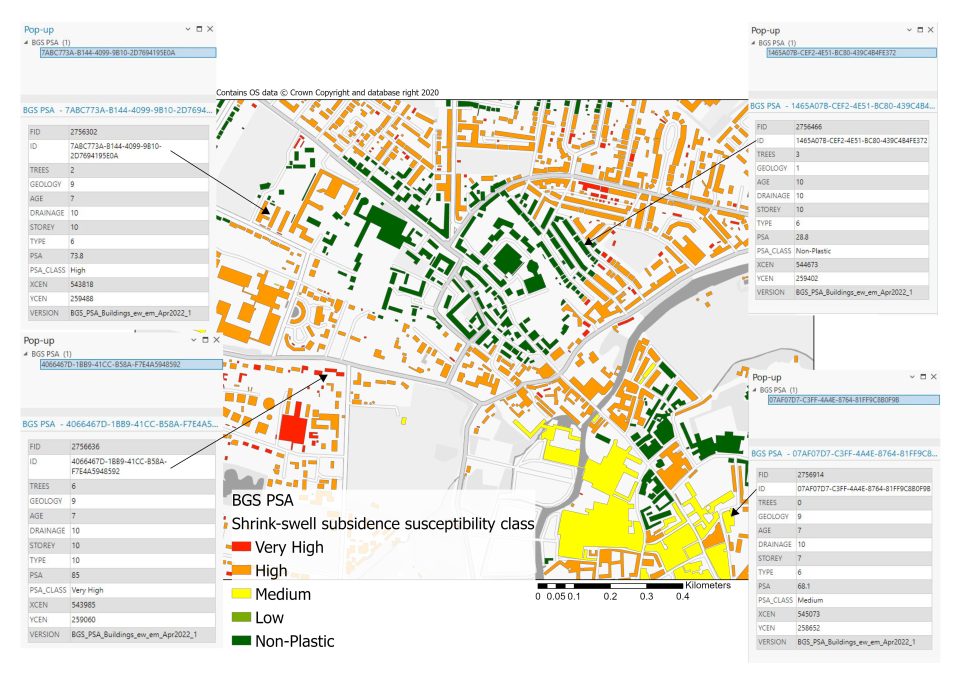
Property subsidence assessment example. BGS © UKRI.
What is it?
BGS Property Subsidence Assessment (PSA) offers property and postcode-level assessments of shrink–swell susceptibility, considering the potential influences of geological and building characteristics.
How is it different to GeoSure?
PSA focuses solely on the shrink–swell subsidence hazard, providing a higher resolution, specialised assessment. It considers key influencing factors (building characteristics; tree proximity) in its assessment. It is complemented by BGS GeoSure and the BGS GeoSure Insurance Product, which provide assessments of susceptibility for a much broader range of ground instability hazards.
What information does it provide?
This dataset uses a combination of geology, tree location and building characteristics to assess shrink–swell susceptibility. These factors are combined to calculate a subsidence hazard score at the building and postcode scales. A recent BGS blog outlines the features of this dataset in greater detail.
Coverage
- England and Wales
Suitable uses
PSA includes a risk element for the housing stock at postcode and building level, making it ideal for use in the property report and insurance sectors.
BGS GeoSure Extra Shrink–swell 3D
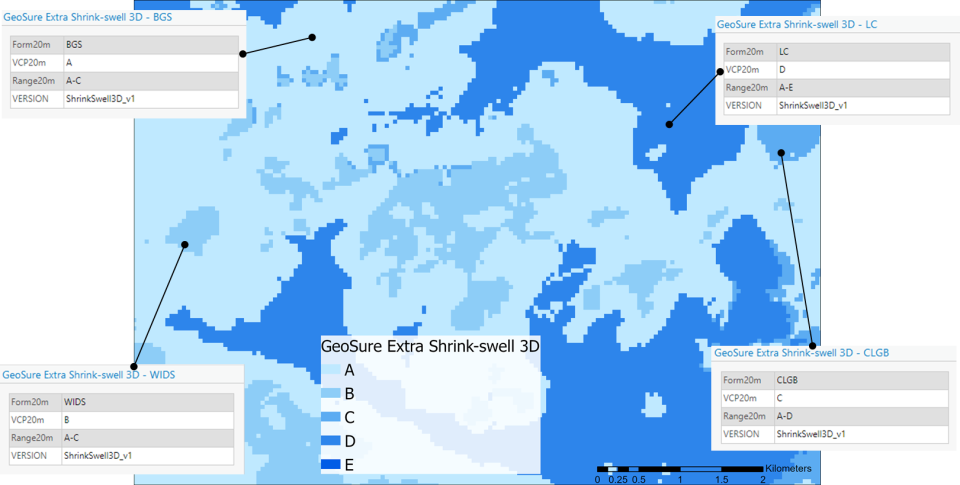
BGS GeoSure Extra Shrink–swell 3D example. BGS © UKRI.
What is it?
The BGS GeoSure Extra Shrink–swell 3D dataset identifies the shrink–swell potential for subsurface or concealed deposits in the London area.
How is it different to BGS GeoSure?
BGS GeoSure provides information on shrink–swell hazard susceptibility in the shallow subsurface (upper 5 m). The 3D model data provides additional information at greater depth, to 20 m.
What information does it provide?
Plasticity ranges in line with GeoSure A to E ratings are applied to data extracted from the London 3D geological model and provided in GIS format. The product identifies areas of potential shrink–swell hazard, in 3D space, down to 20 m in the London Lithoframe area of Great Britain. Shrink–swell/plasticity is provided on a 50 m grid at various depths below surface (1, 2, 3, 4, 5, 10, 15 and 20 m) but can be varied depending on need.
Coverage
- London and the Thames Valley
Suitable uses
This product is designed for the ground engineering markets and infrastructure sectors. Operators for infrastructure such as deep cuttings, tunneling, deep foundations for major construction projects, etc. will find this detailed information useful at a planning stage.
BGS GeoSure Extra Shrink–swell Subsurface
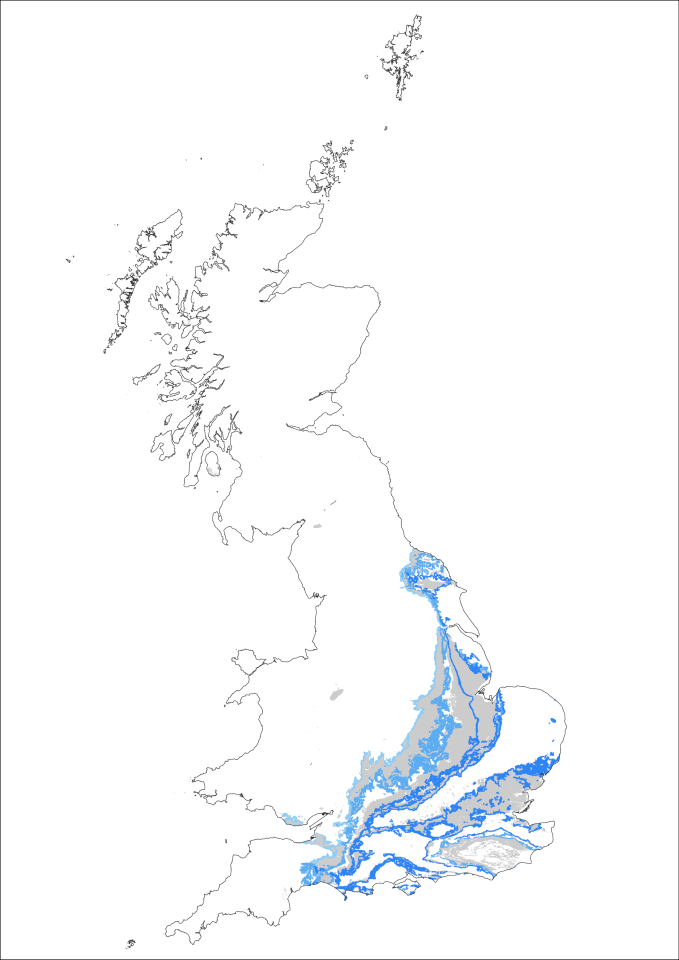
BGS GeoSure Shrink–swell Subsurface coverage. BGS © UKRI.
What is it?
BGS GeoSure Extra Shrink–swell subsurface provides information on shrink–swell potential for shallow subcrop (up to 10 m) clays.
How is it different to BGS GeoSure?
BGS GeoSure provides shrink–swell hazard susceptibility for the upper 5 m of geology only. BGS GeoSure Shrink–swell Subsurface provides a deeper assessment of susceptibility, found beneath other deposits, at a much coarser resolution.
What information does it provide?
This product extends the BGS GeoSure Shrink–swell values into the shallow subsurface, providing information for the eight major clay formations across Great Britain that are underneath another solid formation and therefore hidden from the surface. These are analysed up to 10 m depth for deeper foundation structures.
Coverage
- Partial Great Britain coverage (limited to the main clay formations)
Suitable uses
BGS GeoSure Shrink–swell Subsurface is suitable for screening and desk-based assessments of:
- construction of deep foundations, basements and other such large infrastructure
- infrastructure networks (road and rail)
- utility development
- scoping for civil engineering projects
Contact
If you have any questions or would like to discuss which of these datasets is best suited to your needs, please email the digital data team (digitaldata@bgs.ac.uk).
References
Jones, L D, and Jefferson, I. 2012. Expansive soils. Chapter 33 in ICE Manual of Geotechnical Engineering: Volume I. Burland, J, Chapman, T, Skinner, H, and Brown, M (editors). (London, UK: Institute of Civil Engineers.)
Jones, L, Banks, V, and Jefferson, I. 2020. Swelling and shrinking soils. Engineering Geology Special Publications, Vol. 29, 223–242. (London, UK: Geological Society.)
About the author

Rob Shaw
Geospatial data analyst
Relative topics
Related news
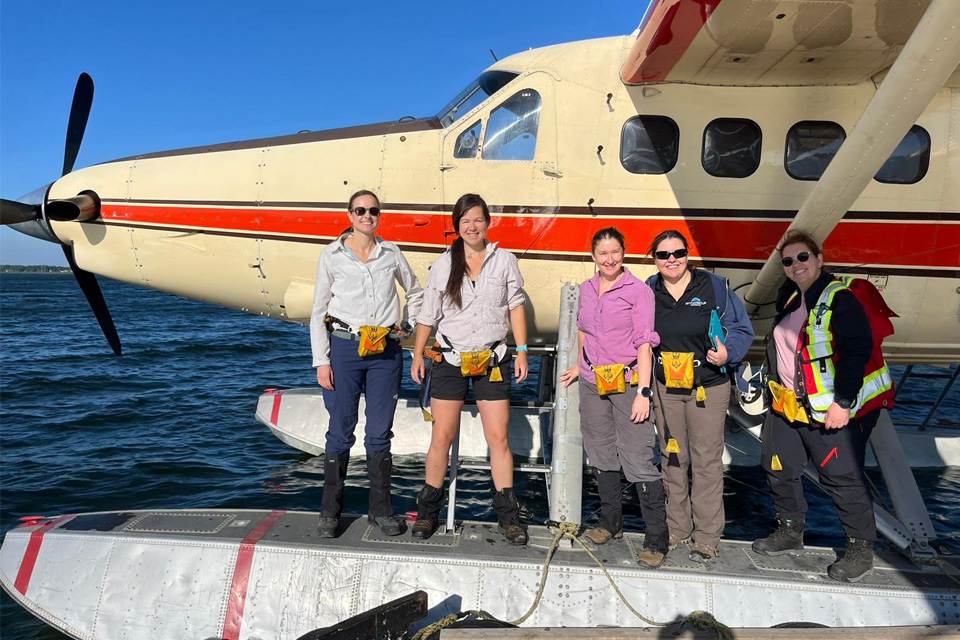
Funding awarded to UK/Canadian critical mineral research projects
08/07/2025
BGS is part of a groundbreaking science partnership aiming to improve critical minerals mining and supply chains.
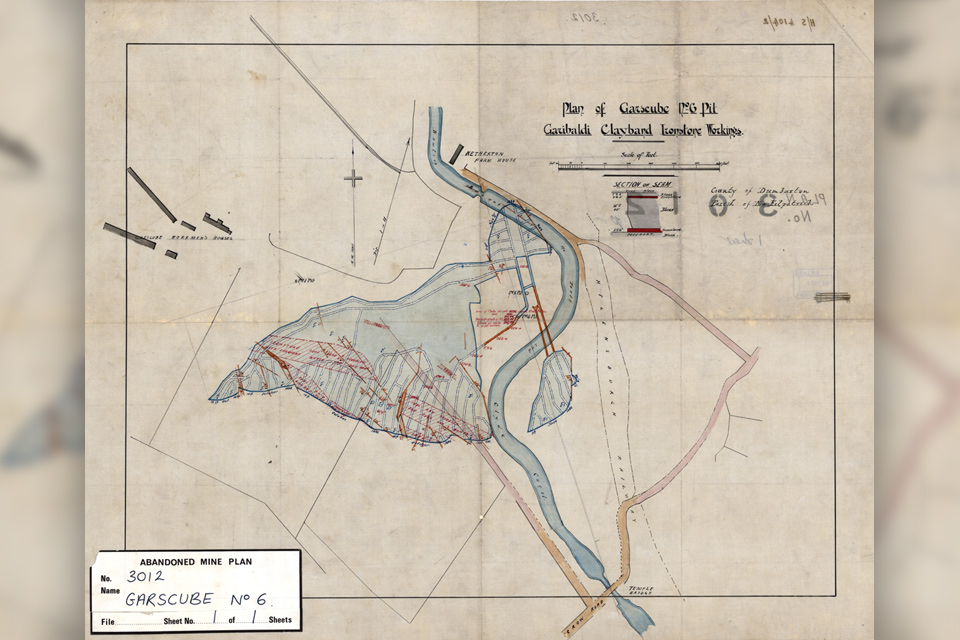
Release of over 500 Scottish abandoned-mine plans
24/06/2025
The historical plans cover non-coal mines that were abandoned pre-1980 and are available through BGS’s plans viewer.
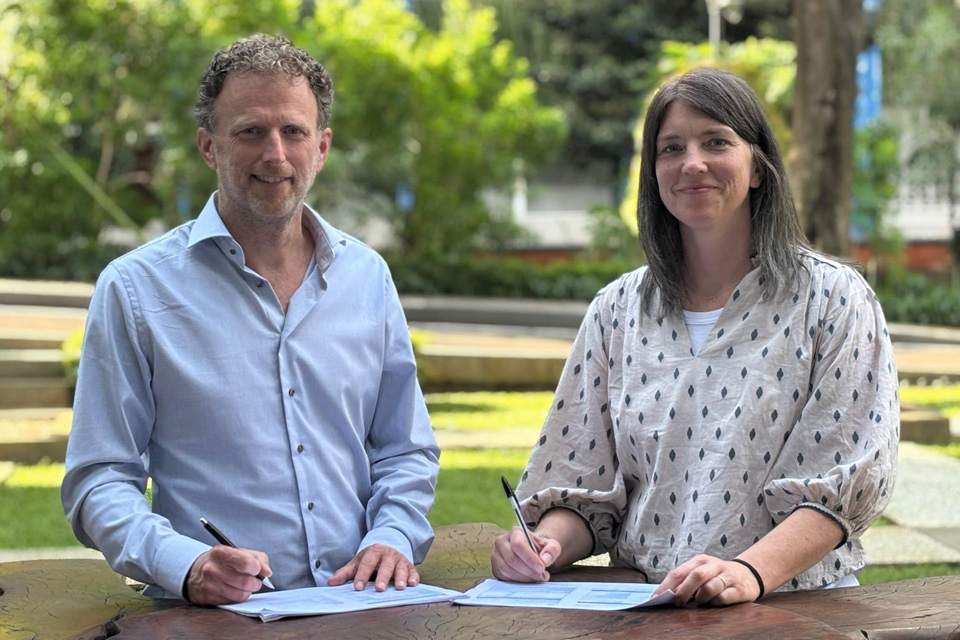
New collaboration aims to improve availability of real-time hazard impact data
19/06/2025
BGS has signed a memorandum of understanding with FloodTags to collaborate on the use of large language models to improve real-time monitoring of geological hazards and their impacts.
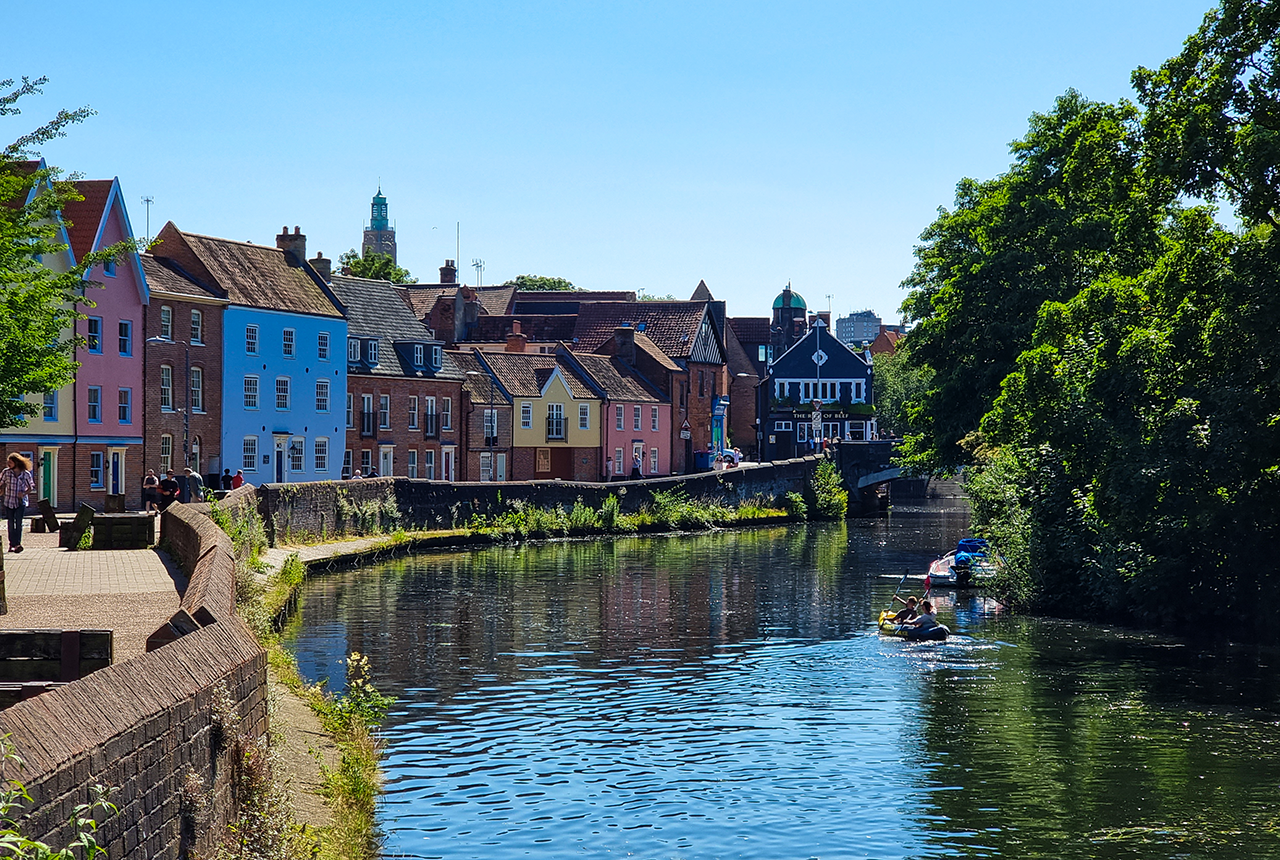
Modern pesticides found in UK rivers could pose risk to aquatic life
17/06/2025
New research shows that modern pesticides used in agriculture and veterinary medicines have been found for the first time in English rivers.

Goldilocks zones: ‘geological super regions’ set to drive annual £40 billion investment in jobs and economic growth
10/06/2025
Eight UK regions identified as ‘just right’ in terms of geological conditions to drive the country’s net zero energy ambitions.
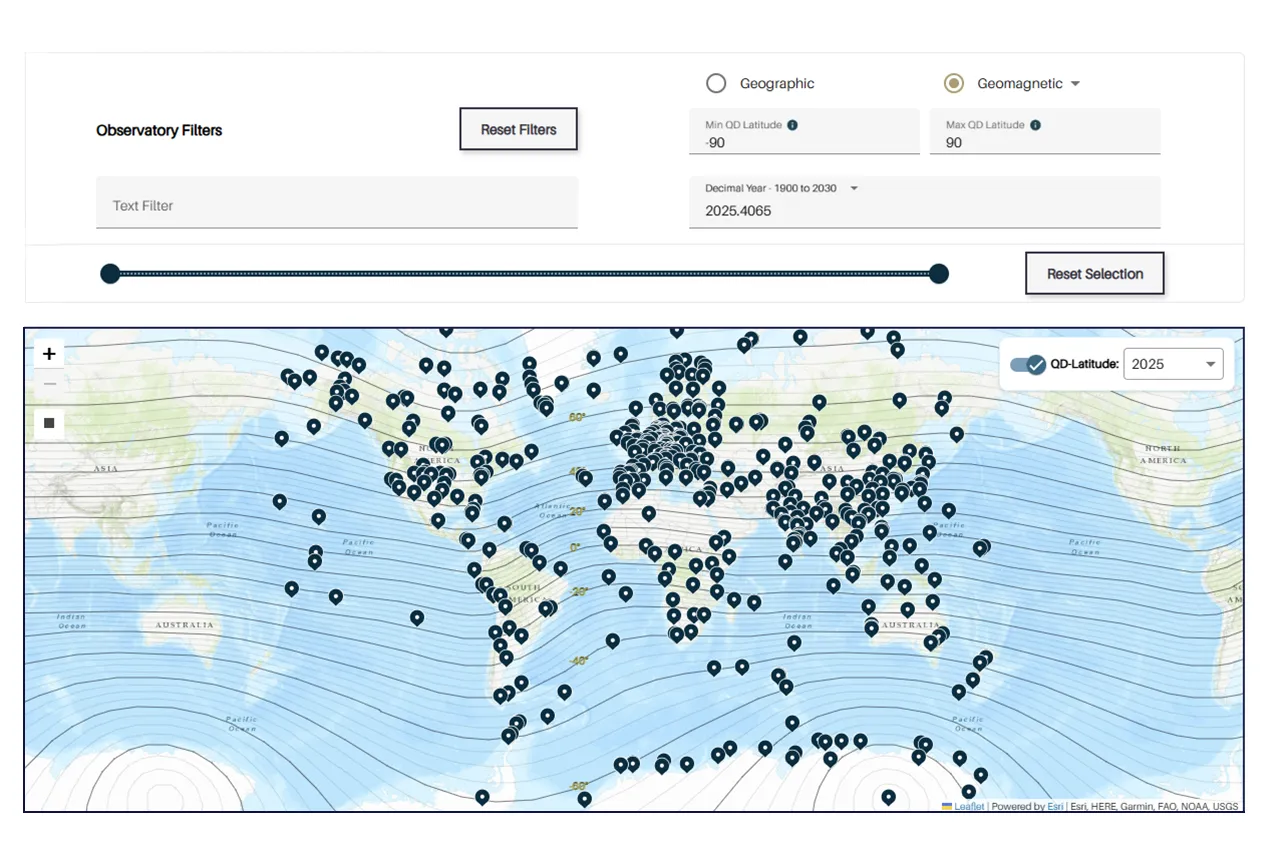
Upgraded web portal improves access to geomagnetism data
02/06/2025
BGS’s geomagnetism portal, which holds data for over 570 observatories across the world, has received a significant update.
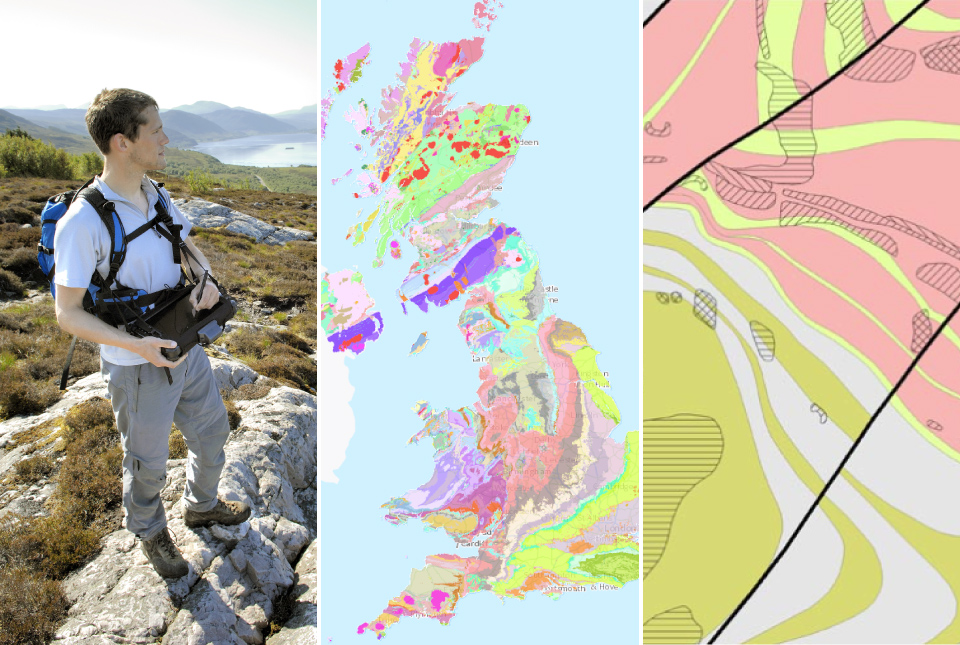
BGS digital geology maps: we want your feedback
29/05/2025
BGS is asking for user feedback on its digital geological map datasets to improve data content and delivery.
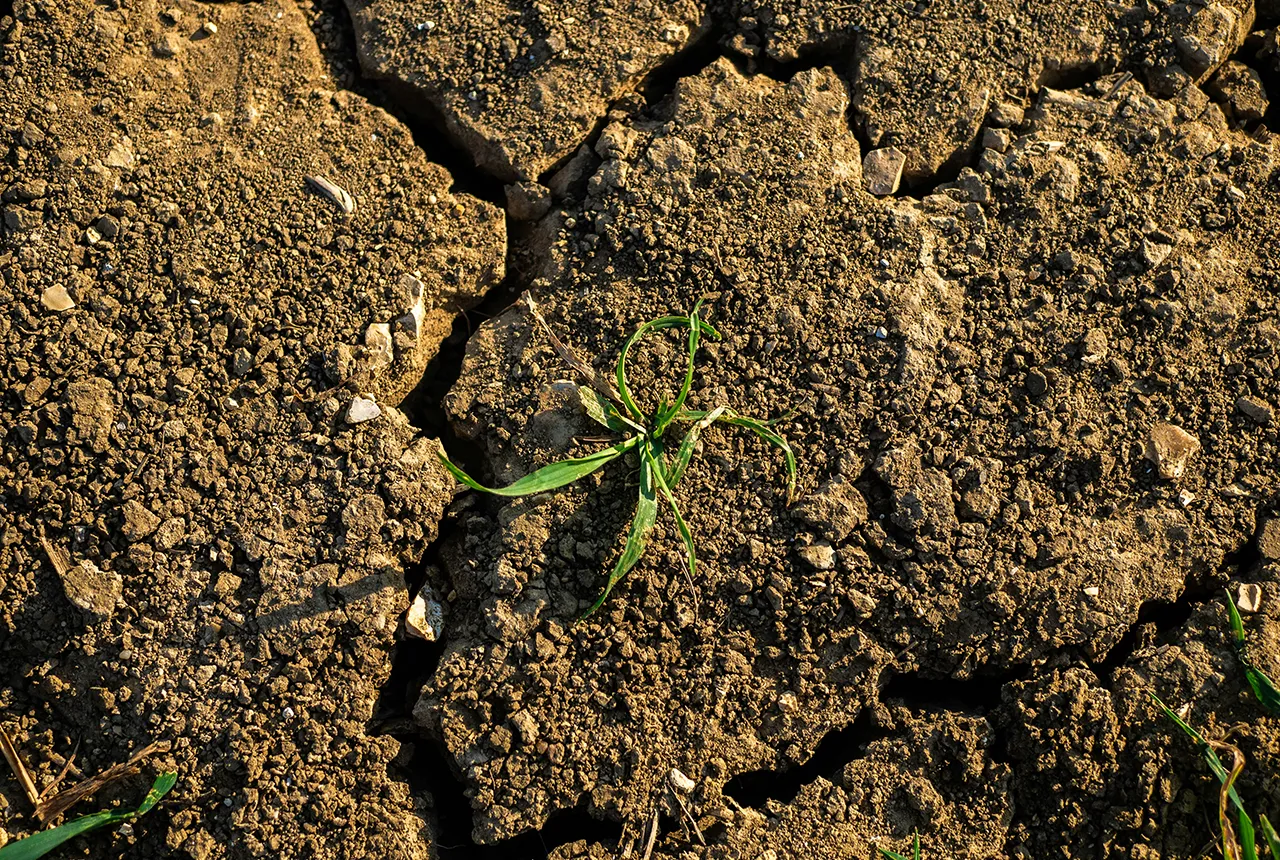
What is the impact of drought on temperate soils?
22/05/2025
A new BGS review pulls together key information on the impact of drought on temperate soils and the further research needed to fully understand it.
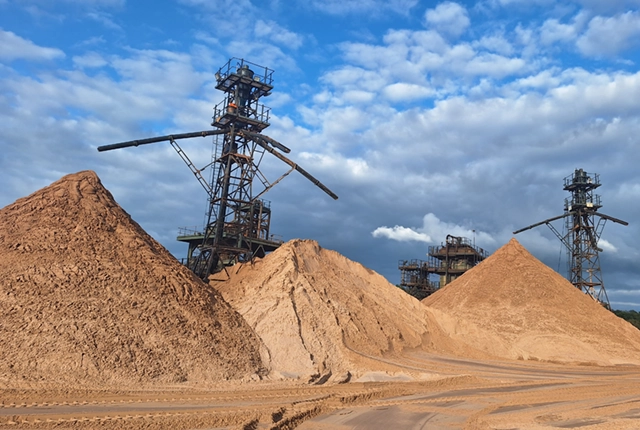
UK Minerals Yearbook 2024 released
21/05/2025
The annual publication provides essential information about the production, consumption and trade of UK minerals up to 2024.
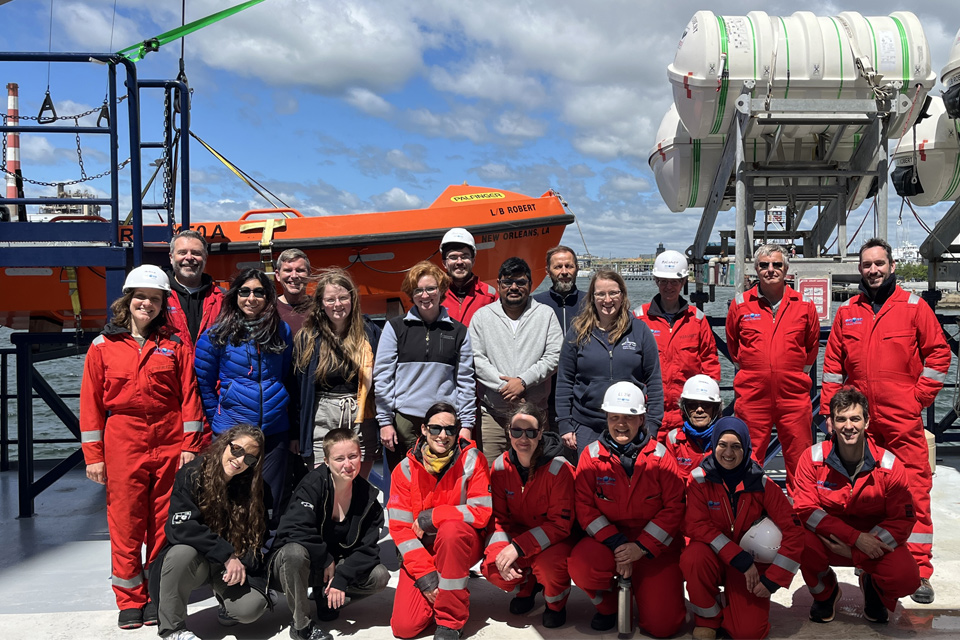
BGS scientists join international expedition off the coast of New England
20/05/2025
Latest IODP research project investigates freshened water under the ocean floor.
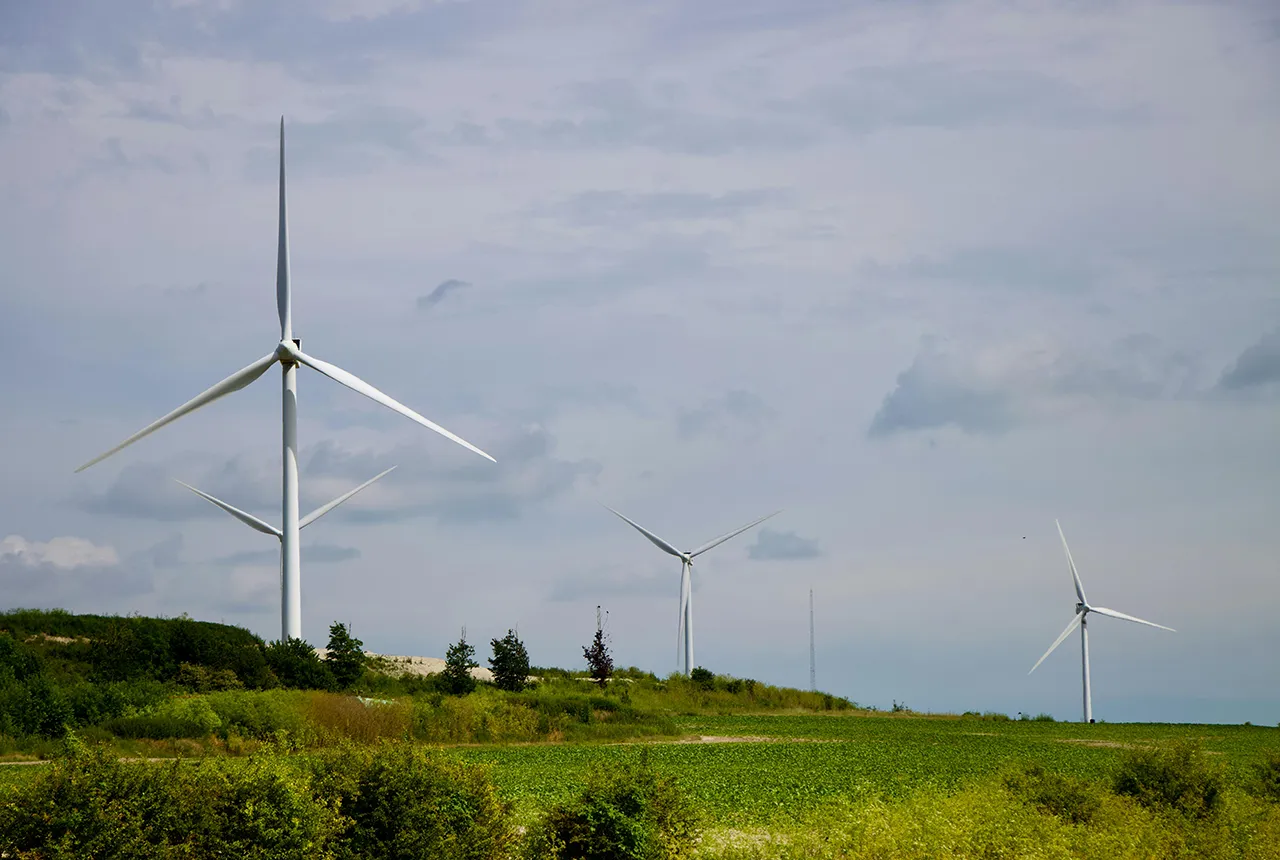
New interactive map viewer reveals growing capacity and rare earth element content of UK wind farms
16/05/2025
BGS’s new tool highlights the development of wind energy installations over time, along with their magnet and rare earth content.

UKRI announce new Chair of the BGS Board
01/05/2025
Prof Paul Monks CB will step into the role later this year.



